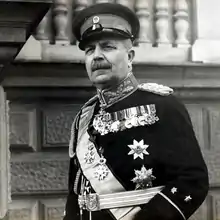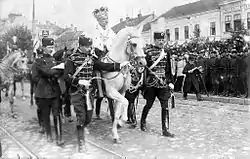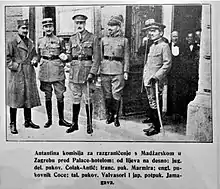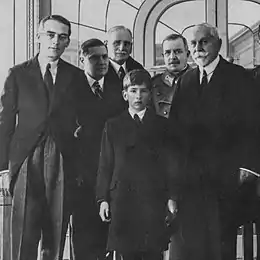Vojin Čolak-Antić
Vojin I. Čolak-Antić (Serbian: Војин Чолак-Антић; 4 August 1877 – 29 July 1945), also known as Vojin Tcholak-Antitch, was a Serbian senior army officer in the Royal Serbian Army and the Royal Yugoslav Army who held a number of senior commands, staff and diplomatic functions.
General Vojin Čolak-Antić | |
|---|---|
 General Vojin Tcholak-Antitch | |
| Native name | Војин Чолак-Антић |
| Other name(s) | Vojin Tcholak-Antitch |
| Born | August 4, 1877 Kragujevac, Principality of Serbia |
| Died | July 29, 1945 (aged 67) Belgrade, Yugoslavia |
| Buried | Novo Groblje, Belgrade |
| Allegiance | |
| Service/ | Royal Serbian Army Royal Yugoslav Army |
| Years of service | 1898–1936 |
| Rank | |
| Commands held |
|
| Battles/wars | |
| Awards | |
| Relations | Boško Čolak-Antić (brother) |
Born into a family with a long military history, he was educated at the Royal Military Academy before training as a staff officer in France. He saw action during both Balkan Wars and the First World War where he served with distinction as a cavalry officer. After the retreat through Albania and the transfer to Corfu, he was appointed head of the Operation Division of the Supreme Command overseeing the 1st Serbian Volunteer Corps in Odessa. After the reorganisation of the Serbian Army and its redeployment along Greece’s northern border, he took command of the 2nd Cavalry Brigade. In the post-war period he was sent to the Paris Peace Conference, as representative of the new Kingdom of SCS to the Border Commission. He then served as Military-Commander of Pecs and Baranya and then as Military Attaché in Bucharest before taking command of the 2nd Cavalry Division.
Among his many decorations Čolak-Antić was awarded the French Legion of Honour for his actions during the Franco-Serb offensive of 1918, and the subsequent breakthrough of the Salonika Front. He later served as Inspector-General of Cavalry and as Aide-de-camp to the young King Peter II Karageorgevic from 1935 to 1939. He died in Belgrade in 1945.[1]
Early life and education
Čolak-Antić was born on 4 August 1877 at his family's home in Kragujevac, the former capital of the Principality of Serbia.[2] As direct descendants of Vojvoda Čolak-Anta Simeonović, one of the leaders of the First Serbian Uprising of 1804, his family was among the most prominent noble military family.[3] His mother, Jelena (née Matić) was a daughter of Minister Dimitrije Matić, the liberal politician and philosopher, who was Minister of Foreign Affairs.[5] At the time of his birth, his father, Colonel Ilija K. Čolak-Antić, was commander of the Ibar Army during the Serbo Turkish War, the successful war of independence Ottoman rule.[3] In 1878, Čolak-Antić's maternal grandfather, Dimitrije Matić, was elected president of the National Assembly of Serbia, which accepted the provisions of the Treaty of Berlin and recognized Serbia's independence. His father became military attaché in Vienna, at the time Serbia's main economic partner. Vojin had a sister and an older brother, Boško, born in 1871 who became a diplomat and a Marshall of the Court.[4]
Vojin was educated at Užice, in western Serbia, as his father prepared him for a military career, he was admitted at the military academy in Belgrade, where his father had taught. He was accepted as an officer cadet in the cavalry. His father died in December 1894, he graduated from the military academy four years later in 1898.
Career
Upon graduation from the Military Academy, as top graduate he was picked to serve with the Royal Serbian Guard, he entered the squadron unit with the rank of sergeant.[5] Even though the conspiracy originated within this elite unit, there is no evidence that he was involved in the plot to assassinate the Royal couple during the May Coup of June 1903. That same year he was commissioned as a cavalry lieutenant and accepted to the senior staff college of the military academy.[5] During the coronation of Peter I of Serbia, he was part of the Honour Guard protecting the sovereign and was selected to lead the King's horse. On 7 November 1904, he was put in command of the First Squadron of the 4th Cavalry Regiment. He continued his General Staff training in the Operation Division of the Supreme Command from 1906 to 1909.[2] In 1909 he was promoted to the rank of Cavalry Major.[5]

In 1910 as a Military Cadet, Čolak-Antić was sent for further training in France, at the 23rd Dragoon Regiment, the famed Royal Piémont. Upon his return to Serbia, he was commissioned cavalry major in the General Staff of the Ministry of War. Čolak-Antić was transferred on 15 October 1911 to the 4th Cavalry Regiment. On 4 April 1912, at the end of his staff training, he was appointed deputy assistant adjutant-general to the Danube divisional area.[5]
Upon the outbreak of the Balkan wars, he was appointed commander of the 2nd Cavalry Regiment Car Dušan.[2] After the end of combats, he was awarded the Medal for Bravery and promoted to the rank of lieutenant colonel on 31 October 1913 for distinguished service in the field.[3]
At the beginning of the First World War, during the first Austro-Hungarian invasions, Vojin Čolak-Antić commanded the 2nd Cavalry Regiment. In the fall of 1915, commanding the same regiment, he joined the retreat through Albania. He was in the Operation Division of the Supreme Command in Corfu and promoted colonel. In April of 1916, he was transferred to the headquarters of the 1st Volunteer Division in the Russian Empire, where he remained until the October Revolution of 1917.[2] After returning to the Salonika front from Russia, he was appointed commander of the 2nd Cavalry Brigade during the successful 1918 offensive that liberated the country.[3]
Postwar

In 1919, while still officially commander of the 2nd Cavalry Brigade, Čolak-Antić was sent to the Paris Peace Conference as part of the Yugoslav delegation. Following the demise of the Austro-Hungarian Empire, the question of the delimitation between Hungary and its neighbouring countries was the subject of intensive talks. In 1920 the Treaty of Trianon ratified the decision to re-draw Hungary's borders.[6] By the Treaty's conclusions, Hungary ceded western Banat , Bačka, Međimurje and Prekmurje to the Kingdom of Serbs, Croats and Slovene. The region of Baranja, with its administrative seat of government in the town of Pécs, was divided with the southern part annexed to the Kingdom of SCS according to a new boundary line, the so-called Clemenceau line.[7]
On 1 August 1921 Colonel Vojin Čolak-Antić was appointed commissioner of the Yugoslav-Hungarian Boundary Commission. The body tasked with defining a definitive delimitation between the two States. The commission work involved studies from lawyers, historians, geographers and other members of the academic community, in order to prepare border documentation, on the basis of Article 29 of the Peace Treaty.[8] The British delegate LL Col. Cree was appointed as its chairman, the other members were Col. Luigi Valvassori (Italy), Lt Col. Marminia (France), Lt Col. Yanagawa (Japan) while Col. Vassel and Col. Vojin Colak-Antic represented respectively Hungary and the Kingdom of the Serbs, Croats and Slovenes. The city of Varaždin was chosen as the seat of the border commission, a further meeting was organised for 18 August 1921.[9]
The occupation of Pécs and Baranja by the Serbian army provoked some resistance from workers who wanted to be connected to revolutionary events taking place at the time in Hungary.[10] After the collapse of the uprising in Hungary, in August 1919, a large number of emigrants took shelter in Pécs. The workers, reinforced by the sudden influx, took over the administration of the city, along with the civilian forces. On 5 August 1921, the Conference of Ambassadors gave instructions for the Yugoslav withdrawal of southern Hungary and asked the Yugoslav government to appoint an officer through whom the local Allied Commission might communicate with Belgrade; Colonel Čolak-Antić was appointed Military Commander of Pécs and Baranja during the transitional period; amongst his duties was the handover of the civilian government in Pecs to the Hungarian authorities. The Yugoslav army started to evacuate Pecs and the Baranja in mid-August.[8]

Elections were held and on 19 August 1921, while the withdrawal was taking place, the civil authorities in southern Hungary proclaimed the so-called Baranya-Baja Republic with the painter Petar Dobrović as its elected president.[11] Due to the new political situation, Colonel Vojin Čolak-Antić refused to evacuate the region. The small Republic of Baranya did not manage to gain international recognition and since it depended on the Serbian protection, after the Yugoslav army finally withdrew, Hungarian forces of Miklós Horthy entered into the region bringing it to an end.[10]
On 24 September 1921, Čolak-Antić was appointed commander of the 2nd Cavalry Division.[3] In July 1922 he took part again in the Geneva negotiations as Yugoslav Border Commissioner later joined by Foreign Minister Momčilo Ninčić, in November 1922 the six members of the Border Commission signed the border list.[6] According to historians, the definition of the Hungarian-Yugoslav border was undeniably a major reason for the stabilization of Europe after the First World War and the establishment of a new regional balance.[12]
On 18 July 1923, Čolak-Antić was appointed military envoy in Bucharest and promoted to the rank of brigadier general on 21 October of the same year. He stayed in the Kingdom of Romania until the end of his term on 25 January 1927. On his return, he became acting commander of the Second Cavalry Division and was promoted to the rank of divisional general. He became Inspector General of Cavalry on 11 April 1929 a position he would keep until the end of his career.[2] In 1936 he represented the Kingdom of Yugoslavia at the funeral of King George V in London.[13] In 1935 he was appointed Aide-de-camp to the young King Peter II Karadjordjevic.[2]
Marriage and family
Vojin Čolak-Antić married in 1904 Marija Grujić, daughter of Prime Minister Sava Grujić, and descendant of Vojvoda Vule Ilić Kolarac. The couple had one daughter, Simonida, and three sons who all became officers of the Royal Yugoslav army:
- Major Ilija Čolak-Antić (1905–1974),
- Major Grujica Čolak-Antić (1906–1967)
- Lieutenant Colonel Peter Čolak-Antić (1907–1964)
References
| Wikimedia Commons has media related to Vojin Čolak-Antić. |
- Jarman 1997, p. 668.
- Bjelajac 2004, p. 135.
- Bjelajac 2004, p. 136.
- Foreign Office 2008, p. 1224.
- First World War 2020.
- Biagini & Motta 2014, p. 310.
- United States Congress 1948, p. 116.
- Domonkos 1999, p. 64.
- Biagini & Motta 2014, p. 311.
- Biagini & Motta 2014, p. 316.
- Biagini & Motta 2014, p. 315.
- Biagini & Motta 2014, p. 317.
- The Gazette 1936.
Sources
- Bjelajac, M. (2004). Generals and Admirals of the Kingdom of Yugoslavia 1918-1941: a study of the military elite (in Serbian). Institute for Serbian History. ISBN 8670050390.
- Jarman, R.L. (1997). Yugoslavia: Political Diaries, 1918-1965. Archive Editions Limited. ISBN 978-1-85207-950-5.
- Domonkos, L. (1999). 33 months in Baranya, 1918-1921 (in Hungarian). Püski. ISBN 978-963-9188-39-6.
- United States Congress (1948). Congressional Record: Proceedings and Debates of the ... Congress. U.S. Government Printing Office. p. 1-PA116.
- "Čolak-Antić I. Vojin". First World War (in Serbian). 2020-05-15.
- Biagini, A.; Motta, G. (2014). Empires and Nations from the Eighteenth to the Twentieth Century: Drafting the Hungarian-Yugoslav border. Cambridge Scholars Publisher. ISBN 978-1-4438-6542-5.
- Foreign Office (2008). Documents on the foreign policy of the Kingdom of Serbia (in Serbian). 2. Serbian Academy of Sciences and Arts.CS1 maint: ref=harv (link)
- Petrovich, M.B. (1976). A History of Modern Serbia, 1804-1918. Harcourt Brace Jovanovich.
- "London Gazette Supplement 34279, 29 April 1936 -". The Gazette. 1936-04-29.